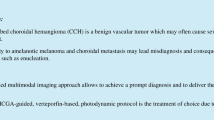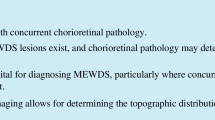Abstract
· Background: The main cause of vision loss in patients with angioid streaks is choroidal neovascularization and subsequent macular degeneration. Indocyanine green angiography allows visualization of the choroidal circulation and may be superior to fluorescein angiography in the evaluation of patients with angioid streaks. · Methods: The ophthalmoscopic, fluorescein and indocyanine green angiographic characteristics of angioid streaks were studied in 34 patients with such streaks. Nineteen patients had pseudoxanthoma elasticum and 15 patients had isolated angioid streaks. The fluorescence characteristics of the ’peau d’orange’ and of choroidal neovascularization, when present, were also analyzed. · Results: Angioid streaks may be hyperfluorescent, hypofluorescent or invisible on indocyanine green angiography. Hyperfluorescent streaks were found in 88% of eyes, hypofluorescent streaks in 11%; in 18% of eyes some streaks were not visualized by indocyanine green angiography. The peau d’orange stained as a speckled pattern in the midperiphery; the flecks were concentrated temporal to the macula. Eighteen eyes presented classic and 6 occult choroidal neovascularization. In several eyes a plaque-like lesion was seen on indocyanine angiography that did not correspond to occult choroidal neovascularization on fluorescein angiography. · Conclusion: Indocyanine angiography outlines angioid streaks as well as the peau d’orange appearance better than fluorescein angiography in the majority of cases. In some cases, however, funduscopically visible streaks can not be visualized. Sometimes classic choroidal neovascular membranes are not visualized by conventional indocyanine green angiography. Occult choroidal neovascularization is better defined by indoycanine green angiography. The fluorescence of angioid streaks and of plaque-like lesions makes the interpretation of indocyanine green angiography difficult.
Similar content being viewed by others
Author information
Authors and Affiliations
Additional information
Received: 18 April 1997 Revised version received: 18 August 1997 Accepted: 18 August 1997
Rights and permissions
About this article
Cite this article
Lafaut, B., Leys, A., Scassellati-Sforzolini, B. et al. Comparison of fluorescein and indocyanine green angiography in angioid streaks. Graefe's Arch Clin Exp Ophthalmol 236, 346–353 (1998). https://doi.org/10.1007/s004170050089
Issue Date:
DOI: https://doi.org/10.1007/s004170050089




